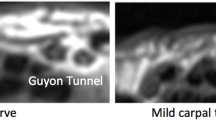Abstract
Purpose
To study variations in the anatomical relationships of the branches of the ulnar nerve in Guyon’s canal relative to the hamulus of hamate (HH) in a grip encountered among cyclists.
Materials and methods
Forty-seven wrist examinations were performed on a 3-T MRI (soft antenna, 16 channels) in propeller sequence in the plane perpendicular to the carpus in 28 healthy volunteers in three cycling positions (neutral, hyperextension and ulnar deviation). The positions and distance between the superficial (SB) and deep (DB) branches of the ulnar nerve with respect to the HH were determined on the section passing through the HH.
Results
The mean distances between the SB (d s) and DP (d p) and HH were 2.4 and 0.6 mm, respectively. The d s in hyperextension and ulnar deviation were 2.2 mm (P = 0.3) and 3 mm (P = 0.07), respectively. The d p in hyperextension and ulnar deviation were 0.3 mm (P = 0.02) and 0.5 mm (P = 0.15), respectively. Hyperextended, 60 % of SB and 40 % of DB were close to the HH, and 26 % of DB came directly in contact with it. In ulnar deviation, 30 % of SB and 29 % of DB approached HH, and 47 % of DB were in contact with it.
Conclusion
This study shows that SB and DB positions of the ulnar nerve vary with respect to the HH depending on the position of the wrist, and such differences may promote Guyon’s canal syndrome in cyclists.



Similar content being viewed by others
References
Blum AG, Zabel JP, Kohlmann R, Batch T, Barbara K, Zhu X, Dautel G, Dap F (2006) Pathologic conditions of the hypothenar eminence: evaluation with multidetector CT and MR imaging. Radiogr Rev Publ Radiol Soc North Am Inc 26:1021–1044. doi:10.1148/rg.264055114
Brown CK, Stainsby B, Sovak G (2014) Guyon canal syndrome: lack of management in a case of unresolved handlebar palsy. J Canadian Chiropractic Assoc 58:413–420
Capitani D, Beer S (2002) Handlebar palsy—a compression syndrome of the deep terminal (motor) branch of the ulnar nerve in biking. J Neurol 249:1441–1445. doi:10.1007/s00415-002-0864-4
Chen SH, Tsai TM (2014) Ulnar tunnel syndrome. J Hand Surg 39:571–579. doi:10.1016/j.jhsa.2013.08.102
Claassen H, Schmitt O, Schulze M, Wree A (2013) Variation in the hypothenar muscles and its impact on ulnar tunnel syndrome. Surg Radiol Anatomy SRA 35:893–899. doi:10.1007/s00276-013-1113-5
Cobb TK, Carmichael SW, Cooney WP (1996) Guyon’s canal revisited: an anatomic study of the carpal ulnar neurovascular space. J Hand Surg 21:861–869. doi:10.1016/S0363-5023(96)80205-X
Earp BE, Floyd WE, Louie D, Koris M, Protomastro P (2014) Ulnar Nerve Entrapment at the Wrist. J Am Acad Orthopaed Surg 22:699–706. doi:10.5435/JAAOS-22-11-699
Eckman PB, Perlstein G, Altrocchi PH (1975) Ulnar neuropathy in bicycle riders. Arch Neurol 32:130–132
Gil YC, Shin KJ, Lee JY, Hu KS, Kim HJ, Song WC, Koh KS (2015) Topographic anatomy of the ulnar tunnel. Surg Radiol Anatomy SRA. doi:10.1007/s00276-014-1415-2
Kwon JY, Kim JY, Hong JT, Sung JH, Son BC, Lee SW (2011) Position change of the neurovascular structures around the carpal tunnel with dynamic wrist motion. J Korean Neurosurg Soc 50:377–380. doi:10.3340/jkns.2011.50.4.377
Patterson JM, Jaggars MM, Boyer MI (2003) Ulnar and median nerve palsy in long-distance cyclists. A prospective study. Am J Sports Med 31:585–589
Pearce C, Feinberg J, Wolfe SW (2009) Ulnar neuropathy at the wrist. HSS J Musculoskeletal J Hospital Special Surg 5:180–183. doi:10.1007/s11420-009-9110-2
Pierre-Jerome C, Moncayo V, Terk MR (2011) The Guyon’s canal in perspective: 3-T MRI assessment of the normal anatomy, the anatomical variations and the Guyon’s canal syndrome. Surg Radiol Anatomy SRA 33:897–903. doi:10.1007/s00276-011-0842-6
Ruszkowski I, Pecina M (1970) Ulner nerve compression in the wrist (Guyon canal syndrome). Lijec Vjesn 92:781–787
Shea JD, McClain EJ (1969) Ulnar-nerve compression syndromes at and below the wrist. J Bone Joint Surg Am 51:1095–1103
Slane J, Timmerman M, Ploeg HL, Thelen DG (2011) The influence of glove and hand position on pressure over the ulnar nerve during cycling. Clin Biomech 26:642–648. doi:10.1016/j.clinbiomech.2011.03.003
Zeiss J, Jakab E, Khimji T, Imbriglia J (1992) The ulnar tunnel at the wrist (Guyon’s canal): normal MR anatomy and variants. AJR Am J Roentgenol 158:1081–1085. doi:10.2214/ajr.158.5.1566671
Acknowledgments
We would like to thank Professor Xavier Demondion for his guidance and valuable advice.
Author information
Authors and Affiliations
Corresponding author
Ethics declarations
Conflict of interest
The authors declare that they have no conflicts of interest for this study.
Rights and permissions
About this article
Cite this article
Rauch, A., Teixeira, P.A.G., Gillet, R. et al. Analysis of the position of the branches of the ulnar nerve in Guyon’s canal using high-resolution MRI in positions adopted by cyclists. Surg Radiol Anat 38, 793–799 (2016). https://doi.org/10.1007/s00276-015-1612-7
Received:
Accepted:
Published:
Issue Date:
DOI: https://doi.org/10.1007/s00276-015-1612-7




